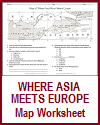| Byzantine Empire Writing Exercises Sheet #1 |
|---|
| www.studenthandouts.com > World History > Byzantine Empire > Byzantine Empire Worksheets |
 |
 |
|---|
|
Byzantine Empire Writing Exercises Sheet #1: Answer each of the following questions using complete sentences. 1. Describe the geographic factors that made Constantinople a center of cultural diffusion, military defense, and trade. Constantinople's location on the Bosporus Strait, between Europe and Asia, made it a prime center for trade, cultural exchange, and military defense. It connected key land and sea routes, allowing goods and ideas to flow between continents. Surrounded by water on three sides and fortified by strong walls, the city was easily defended, making it a powerful and influential hub for centuries. 2. How were the Roman and Byzantine empires connected? The Byzantine Empire was the eastern continuation of the Roman Empire after its western half fell in 476 C.E. Centered in Constantinople, it preserved Roman law, government structures, and culture, while gradually adopting Greek language and Orthodox Christianity. Emperors like Justinian sought to restore Roman glory, linking the two empires through shared heritage and enduring influence. 3. Explain how Emperor Justinian adapted Roman law for use by the Byzantines. Emperor Justinian adapted Roman law for the Byzantine Empire by ordering the compilation and organization of centuries of Roman legal texts into a unified system known as the Corpus Juris Civilis, or Body of Civil Law. This legal code clarified and preserved Roman principles, making them more accessible and applicable for Byzantine use. It influenced later European legal systems. Click here to print this sheet of writing exercises (PDF). Answers will vary. |
|---|
|
Constantinople's strategic location on the Bosporus Strait made it a vital hub for cultural diffusion, military defense, and trade. It connected Europe and Asia, facilitating the exchange of goods, ideas, and cultures. The city's natural harbor, the Golden Horn, provided protection and access for trade ships. Its defensible position, with water on three sides and formidable walls, made it a military stronghold, safeguarding the city for centuries. The Byzantine Empire was the direct continuation of the Roman Empire, with its capital established at Constantinople by Emperor Constantine in 330 C.E. While the Western Roman Empire fell in 476 C.E., the Eastern Roman Empire, known as the Byzantine Empire, preserved Roman legal, cultural, and architectural traditions. The Byzantines spoke Greek and adopted Orthodox Christianity, serving as a bridge between the ancient Roman world and medieval Europe. Emperor Justinian adapted Roman law for the Byzantine Empire by commissioning the Corpus Juris Civilis, or Body of Civil Law, completed in 529-534 C.E. This comprehensive codification streamlined and updated centuries of Roman legal texts, eliminating contradictions and obsolete laws. It consisted of the Code, Digest, Institutes, and Novels, serving as the foundation of Byzantine legal practice and influencing European legal systems for centuries. |
|---|
| Byzantine Empire Books and Films | Byzantine Empire Outlines and PowerPoints |
| Byzantine Empire Maps and Pictures | Byzantine Empire Study Games |
| Byzantine Empire Miscellany | Byzantine Empire Worksheets |
| www.studenthandouts.com > World History > Byzantine Empire > Byzantine Empire Worksheets |










